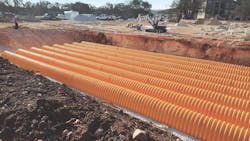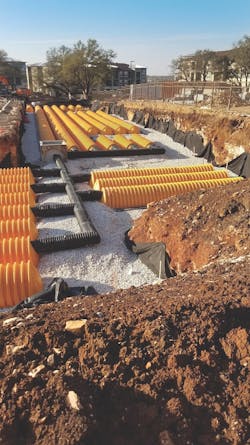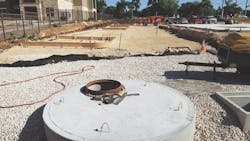About the author:
Steve Cooper is writer for SCA Communications. Cooper can be reached at [email protected].
To protect the Edwards Aquifer, the site developer of the new Natural Grocers store in Georgetown, Texas, decided to use two storm water management systems to provide a higher-than-usual rate of filtration and trapping of debris.
On the corner of West University Blvd. and Wolf Ranch Parkway, the Natural Grocers store is part of the rapid growth of the 1,100-acre Wolf Ranch planned community.
Now under construction, the community will have 2,400 single-family homes and 900 multifamily units, plus shopping areas and the Wolf Ranch Town Center. Storm water quality standards for the development are established by the Texas Commission on Environmental Quality (TCEQ).
Running under most of south central Texas, the Edwards Aquifer is the main source of drinking water for nearly two million people and the primary water supply for agriculture and industry in the region.
Because of its karst hydrogeology, chemicals and debris that enter the system can move through the aquifer and quickly contaminate the water. Aquifers in general can easily be contaminated when pollutants enter the recharge zone.
The prime goals for the developer of the Natural Grocers property were to protect the aquifer as much as possible and also provide maximum control for storm water runoff at the 1.6-acre Wolf Ranch site.
“Initially, our engineers looked at options including an open pond, along with a sand filtration system and standard large concrete detention basin underneath,” said Kevin Beck, development manager for Equity Ventures Commercial Development. “When we looked at cost and the constructability of those items, it turned out to be challenging for this site. So we started looking at options and contacted Advanced Drainage Systems to have them look at the project and to find out if its products were approved for the Edwards Aquifer. There are many that aren’t due to the sensitivity of the area. They did come back and say they had been approved through appropriate groups within the state of Texas, and so we were able to move forward with looking at design options for water detention and water quality at the same time and meet the required removal amount of total suspended solids.”
According to Beck, within Texas and the Austin area there is significant sensitivity to the environmental areas.
“This aquifer is of particular importance to the state and to the region, and therefore to protect it and still allow development, we wanted to go with the higher removal rates to be very protective of that aquifer,” Beck said.
The storm water management system Beck decided on consists of two units that work in tandem and was designed to handle a 100-year storm with a capacity of nearly 17,000 gal of water. Runoff enters the chamber system with an in-line treatment unit. It then moves to another filtration system, and is discharged into the San Gabriel River.
“Water quality approval is through the Texas Commission on Environmental Quality. This is the minimum requirement in Georgetown to be considered, but they have additional requirements as well,” Beck said. “We worked directly with the engineer and the city to convince them that we met and exceeded these additional requirements. Ultimately, the approval had to come from the city engineer. The project was permitted through TCEQ in the early spring of 2018, construction started in March, and the store opened in September.”
The storm water detention system, with an installed volume of 2,255 cu ft of water, consists of 198 StormTech SC-740 chambers with an Isolator Row, also constructed from the chambers. Water enters the system from one grate in the parking lot and moves into the Isolator Row, which is the first area to trap sediments and other contaminants. The water then enters the BayFilter Model 522 with six removable filters for additional treatment. The BaySaver Technologies’ BayFilter system is designed to remove fine sediments using replaceable spiral-wound media filters. It meets the Edwards Aquifer Rules Technical Guidance on Best Management Practices RG-348.
“With this combined system, we were able to achieve 87% removal of Total Suspended Solids,” Beck said.
Installing the storm water management system underground instead of using the land for an open pond provided more parking spaces for the store. StormTech chambers are designed in accordance with AASHTO Load and Resistance Factor Design Bridge Design Specification Section 12.12 design standard and ASTM F-2787 Standard Practice for Structural Design of Thermoplastics Chambers in accordance with AASHTO Section 12.12. Meeting these standards assures the chambers provide live and dead load safety factors and structural integrity. Manufactured using polyethylene and polypropylene, the chambers are rated by ADS for a 75-year service life. The StormTech Isolator Row System provides total suspended solids separation and extends maintenance intervals.
The manifolds were constructed from ADS N-12 corrugated high-density polyethylene pipe, and perforated 6-in.-diameter N-12 pipe was used for a perimeter underdrain system.
“Because this project is above the Edwards Aquifer, that is the reason why we used the two systems we did,” Beck said. “There are stringent guidelines regarding pollutant removal from storm water runoff in this area, which we exceeded, removing 87% of the particulates, including oils, fuels, dirt and sand plus debris.”
About the Author
Steve Cooper
Steve Cooper is a writer for SCA Communications. Cooper can be reached at [email protected].



